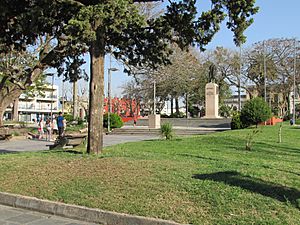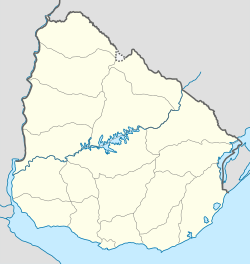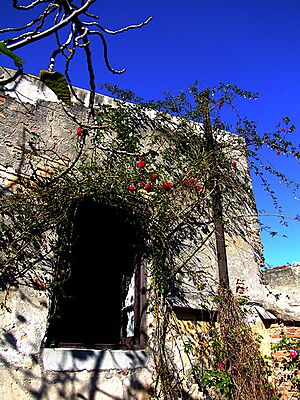Melo, Uruguay facts for kids
Quick facts for kids
Melo
|
|
|---|---|
|
Capital city
|
|

Artigas Monument and Plaza Constitución
|
|
| Country | |
| Department | |
| Founded | 1795 |
| Founded by | Agustín de la Rosa |
| Elevation | 80 m (260 ft) |
| Population
(2011 Census)
|
|
| • Total | 51,830 |
| • Demonym | melense |
| Time zone | UTC -3 |
| Postal code |
37000
|
| Dial plan | +598 464 (+5 digits) |
| Climate | Cfa |
Melo is an important city in north-eastern Uruguay. It is the capital city of the Cerro Largo Department. In 2011, it was the ninth largest city in Uruguay by population.
Contents
Geography of Melo
Where is Melo located?
Melo is found in the middle of the Cerro Largo department. It sits where two main roads meet: Route 7 and Route 8. The city is about 60 kilometers (37 miles) south of Aceguá. Aceguá is right on the border with Brazil. Other important roads leading to Melo are Route 26 and Route 44.
A small river called Arroyo Conventos flows along the western edge of the city. This river is a branch of the Tacuarí River.
What is Melo's climate like?
Melo has a humid subtropical climate. This means it has warm summers and cool winters. Summers often have hot days but cool nights. Winters can be quite chilly, with many frosts and fog.
Rainfall is spread out evenly throughout the year. On average, Melo gets about 1,241 millimeters (48.85 inches) of rain each year. The average temperature for the whole year is around 17 °C (63 °F).
Melo holds the record for the lowest temperature ever recorded in Uruguay. On June 14, 1967, the temperature dropped to a very cold -11 °C (12.2 °F).
History of Melo
Founding and early invasions
Melo was founded on June 27, 1795. It was started by Agustín de la Rosa, who was an officer for the Spanish Empire. The city was named after Pedro Melo de Portugal. He was a Spanish official with Portuguese family roots.
Because Melo was close to some Portuguese areas in Brazil, it was invaded several times. Portuguese forces attacked the "Melo Village" in 1801, 1811, and 1816. After Uruguay became an independent country, Melo was officially made the capital of the Cerro Largo department.
Melo's political connections
In 1845, the main city square was renamed to honor Manuel Oribe. He was a former President of Uruguay and a leader of the White Party (Partido Blanco). This showed how connected Melo was to this important political group. Most people living in Melo at that time supported the White Party.
Melo became a "Villa" (town) before Uruguay gained its independence. Later, on May 22, 1895, it was officially made a "Ciudad" (city) by a special law (Ley Nº 2.3279). Melo was one of the nine original departments in the new Republic of Uruguay.
Melo's population growth
In 2011, Melo had a population of 51,830 people. The city has grown a lot over the years. Here's how its population has changed:
| Year | Population |
|---|---|
| 1908 | 12,355 |
| 1963 | 33,741 |
| 1975 | 38,487 |
| 1985 | 42,245 |
| 1996 | 46,883 |
| 2004 | 50,578 |
| 2011 | 51,830 |
Source: Instituto Nacional de Estadística de Uruguay
Interesting places in Melo
Museums and historical sites
Melo has two interesting museums to visit:
- Juana de Ibarbourou's birthplace: This is the house where the famous poet Juana de Ibarbourou was born.
- Regional History Museum: Here you can learn about the history of the region.
Close to Melo, you can find the old Posta del Chuy. This is a stone inn located near an old bridge. The bridge crosses the Chuy del Tacuarí creek.
Pope John Paul II's visit
In 1988, Pope John Paul II visited Melo. This special event inspired a 2006 film called El Baño del Papa (The Pope's Toilet). The movie is about a local person who had a big idea. They thought many people would come to Melo to see the Pope. So, they planned to build a special toilet and charge visitors to use it.
Places of worship in Melo
Melo has several churches, mostly Roman Catholic:
- Cathedral of Our Lady of the Pillar and St. Raphael (Roman Catholic)
- Parish Church of Our Lady of Mt. Carmel (Roman Catholic)
- Parish Church of St. Joseph the Worker (Roman Catholic)
- Parish Church of St. Dominic Savio and St. Charles Borromeo (Roman Catholic, run by the Salesians of Don Bosco)
- Jesus Good Shepherd Parish Church (Roman Catholic, run by the Sisters of Santa Dorotea di Cemmo)
Notable people from Melo
- Saviniano Pérez (1907–1985), a well-known politician.
See also
 In Spanish: Melo para niños
In Spanish: Melo para niños



